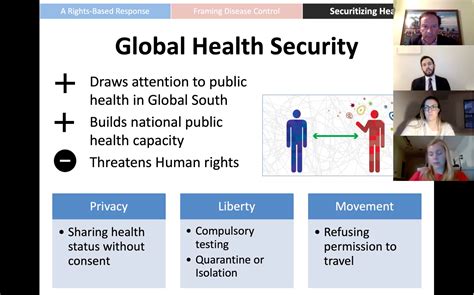Public health programs play a crucial role in addressing the various health challenges faced by communities around the world. In the United States, top universities are at the forefront of developing innovative strategies and solutions to combat infectious diseases, manage chronic conditions, and promote maternal and child health. These programs also focus on reducing health disparities in disadvantaged communities, implementing effective health education and communication strategies, and carrying out community-based interventions. Furthermore, they are actively involved in advancing global health initiatives, utilizing data and research to improve public health outcomes, and collaborating with international organizations to maximize their impact. In this blog post, we will delve into the diverse public health programs offered by top universities in the US and explore how they are working towards solving global health challenges. Join us as we uncover the incredible work being done to create a healthier and more equitable world for all.
Table of Contents
Introduction to Public Health Programs
Public health programs play a crucial role in promoting and protecting the health of communities. These programs are designed to improve the overall well-being of society by addressing various health issues and implementing strategies to prevent disease and injury. By focusing on disease prevention and health promotion, public health programs aim to reduce the burden of illness and improve the quality of life for individuals and communities.
One of the key objectives of public health programs is to identify and address the determinants of health, including social, economic, and environmental factors. By understanding these determinants, public health professionals can develop targeted interventions and policies to address the underlying causes of health problems. Additionally, public health programs strive to create equitable access to healthcare services and resources, ensuring that all individuals have the opportunity to lead healthy lives.
Furthermore, public health programs leverage data and research to identify health trends, assess the effectiveness of interventions, and inform decision-making. This evidence-based approach allows public health practitioners to develop and implement strategies that are tailored to the specific needs of the communities they serve. By utilizing data and research, public health programs can measure the impact of their efforts and continuously improve their approaches to addressing public health challenges.
In essence, public health programs play a vital role in safeguarding the health of populations and promoting well-being. By employing a comprehensive approach that incorporates prevention, intervention, and policy development, these programs are integral to improving the health outcomes of individuals and communities.
Addressing Infectious Diseases through Public Health
In today’s world, infectious diseases pose a significant threat to global public health. From the recent COVID-19 pandemic to the ongoing battle against diseases like malaria, tuberculosis, and HIV/AIDS, it is clear that addressing infectious diseases is a crucial aspect of public health. Governments, organizations, and communities must work together to implement effective strategies for preventing, managing, and controlling the spread of infectious diseases.
One key aspect of addressing infectious diseases through public health is the promotion of vaccination programs. Vaccines have played a critical role in eradicating diseases like smallpox and reducing the impact of others such as polio. By ensuring widespread access to vaccines and promoting vaccination campaigns, public health initiatives can help prevent the spread of infectious diseases and protect entire populations from outbreaks.
Another important strategy for addressing infectious diseases is the implementation of early detection and surveillance systems. By closely monitoring disease outbreaks and identifying potential threats, public health agencies can take swift action to prevent the spread of infectious diseases. This can include measures such as quarantine protocols, travel restrictions, and public health advisories to limit the impact of outbreaks.
Furthermore, public health efforts to address infectious diseases include promoting hygiene and sanitation practices, improving access to healthcare services, and conducting research to develop new treatments and interventions. By focusing on these key areas, public health initiatives can make a significant impact in reducing the burden of infectious diseases on communities and populations around the world.
Preventing and Managing Chronic Diseases
Chronic diseases are long-term health conditions that require ongoing management and care. These diseases, such as heart disease, diabetes, and cancer, are among the leading causes of death and disability worldwide. It is crucial to focus on prevention and management strategies to reduce the burden of chronic diseases on individuals and communities.
One effective approach to preventing chronic diseases is through lifestyle modifications. Encouraging individuals to adopt healthy behaviors such as regular exercise, balanced diet, and smoking cessation can significantly reduce the risk of developing chronic conditions. Additionally, providing education and resources on stress management and mental health can also contribute to prevention efforts.
In terms of managing chronic diseases, access to healthcare plays a significant role. Regular check-ups, medication adherence, and ongoing monitoring are essential for individuals living with chronic conditions. This calls for the need for affordable and comprehensive healthcare services that cater to the needs of individuals with chronic illnesses.
Community-based interventions are also key in preventing and managing chronic diseases. By collaborating with local organizations and healthcare providers, targeted interventions and support programs can be implemented to address the specific needs of at-risk populations. This can include disease management workshops, support groups, and access to resources for managing chronic conditions.
Promoting Maternal and Child Health
Promoting Maternal and Child Health is crucial for the overall well-being of the society. Maternal and child health programs aim to provide access to quality healthcare, improve nutrition, and educate mothers and caregivers. By prioritizing the health of mothers and children, communities can ensure healthy future generations.
Maternal and child health initiatives include prenatal care, postnatal care, immunizations, and nutrition programs. These efforts are essential in reducing maternal and child mortality rates and addressing issues related to malnutrition and preventable diseases.
By promoting maternal and child health, communities can improve the health outcomes of mothers and children, ensuring they have the best possible start in life. This involves creating supportive environments and accessible healthcare services that cater to the specific needs of mothers and children.
Furthermore, promoting maternal and child health involves educating communities about the importance of prenatal care, breastfeeding, and overall child development. By empowering mothers and caregivers with knowledge and resources, communities can create a nurturing environment that fosters the optimal growth and development of children.
Reducing Health Disparities in Underprivileged Communities
Health disparities in underprivileged communities can have devastating effects on the overall well-being of the population. These disparities are often the result of social, economic, and environmental factors that create barriers to accessing quality healthcare. Without proper access to healthcare services, individuals in these communities are at a higher risk for developing chronic conditions and experiencing poorer health outcomes.
Reducing health disparities in underprivileged communities requires a multifaceted approach that addresses the root causes of these disparities. This can involve implementing community-based health interventions that provide outreach and education, as well as advocating for policies that promote equitable access to healthcare services. It is essential to prioritize the needs of these communities and work towards breaking down the barriers that prevent them from receiving the care they deserve.
Additionally, collaboration with local organizations and healthcare providers is crucial in identifying the specific needs of underprivileged communities and developing targeted interventions. By working together, it is possible to create effective health education and communication strategies that resonate with these communities and encourage them to take an active role in their own health.
Ultimately, reducing health disparities in underprivileged communities is a fundamental aspect of public health that not only improves the lives of individuals within these communities but also contributes to the overall health of the population. Through dedicated efforts and collaborative initiatives, it is possible to create positive change and ensure that everyone has the opportunity to achieve optimal health.
Creating Effective Health Education and Communication Strategies
When it comes to promoting public health, one of the key factors is creating effective health education and communication strategies. These strategies are essential in informing and empowering communities to make healthy choices and access necessary services. A well-designed health education program can help individuals understand the importance of preventive care, healthy lifestyle choices, and early detection of diseases.
Another crucial aspect is developing effective communication strategies to reach diverse populations. This includes using multilingual materials, targeted messaging, and culturally sensitive approaches to ensure that information is accessible and relevant to everyone. By utilizing various communication channels, such as social media, community events, and partnerships with local organizations, public health professionals can effectively disseminate important information and resources.
Moreover, incorporating behavioral science principles into health education and communication strategies can enhance their effectiveness. Understanding human behavior and decision-making processes is essential in promoting behavior change and encouraging healthy habits. By applying insights from behavioral science, public health professionals can develop messaging and interventions that resonate with individuals and motivate them to adopt healthier behaviors.
Overall, creating effective health education and communication strategies is vital in promoting public health and empowering individuals to make informed decisions about their health. By utilizing a combination of education, communication, and behavioral science principles, public health professionals can contribute to the overall well-being of communities and address the underlying determinants of health.
Implementing Community-Based Health Interventions
Implementing community-based health interventions is a crucial aspect of public health programs. These interventions aim to address the health needs of specific communities by involving and empowering the community members themselves. By utilizing a bottom-up approach, public health professionals can gain a better understanding of the unique challenges and needs of the community, and tailor interventions accordingly.
One key aspect of implementing community-based health interventions is the need for collaboration with local stakeholders such as community leaders, healthcare providers, and non-profit organizations. This collaboration can help ensure that the interventions are culturally sensitive and well-received by the community.
In addition to collaboration, it is important to conduct thorough assessments of the community’s health needs and resources. This can involve gathering data on prevalent health issues, identifying existing healthcare services, and assessing the community’s capacity for change.
Lastly, monitoring and evaluation are essential components of community-based health interventions. It is important to track the progress and impact of the interventions to ensure that they are effectively addressing the health needs of the community and making a positive impact on public health outcomes.
Advancing Global Health Initiatives
Advancing global health initiatives is crucial in our interconnected world where diseases and health issues can easily spread across continents. One of the key ways to advance global health initiatives is through international collaboration and cooperation. This involves partnerships between different countries, organizations, and stakeholders to work towards a common goal of improving health outcomes on a global scale.
Another important aspect of advancing global health initiatives is through the sharing of best practices and knowledge. This can include the exchange of information on disease management, public health programs, and innovative healthcare solutions. By learning from each other, countries and organizations can implement successful strategies that have been proven to work in different parts of the world.
In addition, advancing global health initiatives also involves addressing the social determinants of health on a global level. This includes tackling issues such as poverty, access to clean water and sanitation, education, and gender equality, all of which have a significant impact on population health. By working towards addressing these underlying factors, global health initiatives can have a more sustainable and meaningful impact.
Furthermore, utilizing data and research to inform global health initiatives is crucial. This can involve monitoring and analyzing health trends, outbreak patterns, and epidemiological data to better understand the health needs of different regions. By using evidence-based approaches, global health initiatives can be more targeted and effective in addressing specific health challenges around the world.
Utilizing Data and Research to Improve Public Health
Utilizing data and research to improve public health is crucial in addressing the various health challenges that affect communities around the world. By analyzing and interpreting data, public health professionals can gain valuable insights into disease trends, risk factors, and health outcomes, which can inform evidence-based interventions and policies.
Furthermore, research plays a key role in identifying new strategies for preventing and treating diseases, as well as evaluating the effectiveness of public health programs. This knowledge is essential for making informed decisions that have a positive impact on the health of populations.
Effective data and research practices also support the monitoring and evaluation of public health initiatives, allowing for continuous assessment and improvement. With the use of data, public health organizations can track outcomes, identify areas for improvement, and make necessary adjustments to their strategies to achieve better health outcomes.
Overall, the utilization of data and research is an integral part of efforts to improve public health and address the complex health issues facing communities today.
Collaborating with International Organizations for Public Health Impact
Collaborating with international organizations is crucial for making a significant impact on public health worldwide. International organizations provide resources, expertise, and funding that can greatly benefit public health programs in different countries. By partnering with organizations such as the World Health Organization (WHO), UNICEF, and the Gates Foundation, public health initiatives can gain access to valuable knowledge, support, and networks that can amplify their impact.
When collaborating with international organizations, public health professionals can tap into a wealth of information and best practices from around the world. This can help in improving existing programs, addressing new health challenges, and learning from successful interventions in other countries. Through these collaborations, public health initiatives can benefit from global perspectives and innovative strategies that can be adapted to local contexts.
Furthermore, partnering with international organizations allows for better coordination and alignment of efforts across different regions. This can lead to more effective use of resources, avoidance of duplication, and greater overall impact on public health outcomes. By joining forces with other organizations, public health programs can leverage collective expertise and experiences to tackle complex health issues on a larger scale.
Overall, collaborating with international organizations is essential for maximizing the impact of public health efforts and for achieving global health goals. By working together, organizations can pool their strengths and resources to address the most pressing health challenges facing communities around the world.





